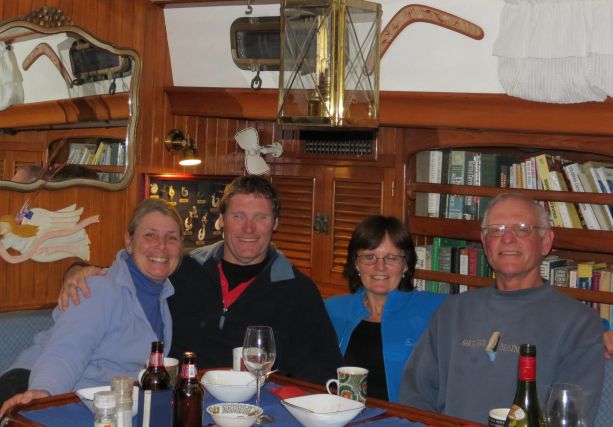Tasmanian Bush Fires - a firsthand account
/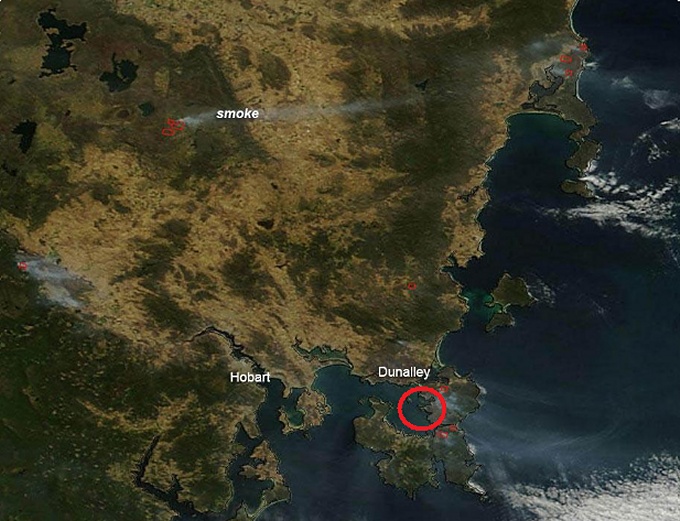
Americans are very familiar with wildfires, especially in the western part of the country. We forget or perhaps are oblivious, however, to similar natural disasters throughout the world. Case in point...the devastating bush fires which have been ravaging Australia and in particular, the fires which continue to rage here Tasmania.
To date, homes and property estimated at over $42M have been lost and over 35 bush fires are still burning. With a total island population hovering around half a million (Boston's estimated population is 625,000), that's a devastating figure. One Victorian firefighter has lost his life. 150,000 acres of bush and farmland have burned and several fires are still out of control. Though conditions are easing here in Tasmania, fires in New South Wales and Victoria continue to blaze on the mainland.
I “met” Jackie Zanetti, a New Jersey-born girl now gone Tasmanian, via e-mail when she asked to publish one of my recipes in her cruising club newsletter. You know how it is with e-mail. After you exchange a few, you feel like you've become friends even though you've never met. Jackie mentioned that she and Alex had been caught up in the bush fires that have devastated parts of the Tasman Peninsular while out on a sailing holiday on their 36' Jeanneau sloop, Chaika. I asked her to share it with us. Here are excerpts and photos from her frightening narrative.
Friday, 4th January 2013. We were anchored in King George Sound near Norfolk Bay and the Tasman Peninsula. By mid-afternoon, we noticed smoke getting much closer and local ABC radio was sending out warnings for Dunalley. The wind started to pick up (WNW) and ash started falling all around us. By 3pm, the wind had increased to over 20 knots funneling up the sound. The smoke became denser and closer and we then noticed we were dragging our anchor in a soft mud patch. Ash was falling on Chaika. Long charred strips of bark were falling in the water around us. A dead bird with singed wings floated past.
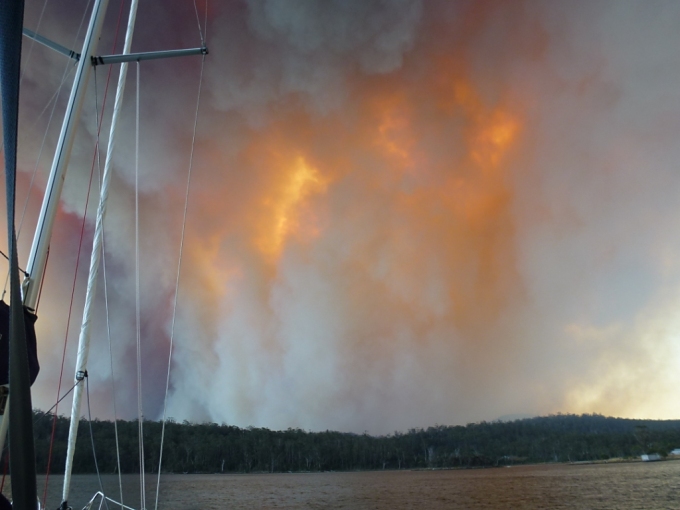
When we spotted the first fire on shore, we were faced with a decision whether to stay or leave. With the twin risks of embers hitting the boat and dragging we decided to leave, but where to go? Winds were now northerly, gusting over 30 knots, so we decided to head back to Sommers Bay, southwest of Murdunna.
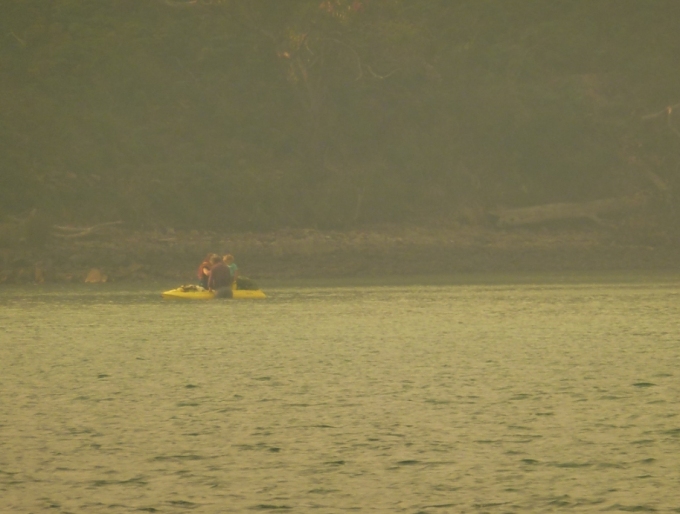
After a wild ride back to Sommers Bay we dug our anchor into a good sandy patch, put out 50m of chain, and prepared ourselves to stay and defend Chaika. We put a couple of buckets with water and rags out in case of embers. As evening came on, we could see the local residents evacuating to the waterfront. Cars and utes (pickup trucks) with dinghies on trailers lined one side of the shore and a few people with sit-upon kayaks waded out from the beach. One kayak had a toddler inside with three adults standing in the water wearing survival back packs. They stood in the same spot in thigh deep water for over two hours.
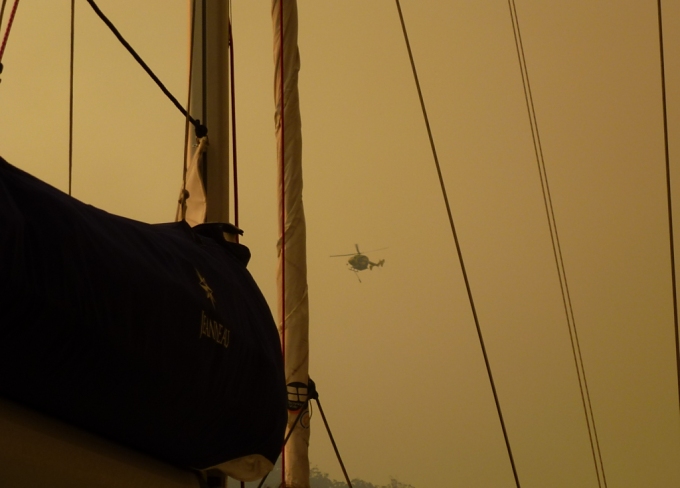
As the smoke grew thicker a water bombing helicopter flew over several times to fill up from a nearby dam. We could see that the fire was moving quickly southward to the east of us and just around dusk the top of the ridge to the east started flaring up with flames rising high into the sky. The heat and the roar of the fire, even though it was on the other side of the ridge, was frightful. We sat in the cockpit, drinking lots of water and waiting to see whether the fire would come down the hill towards the bay. We were prepared to take people on board, if requested.
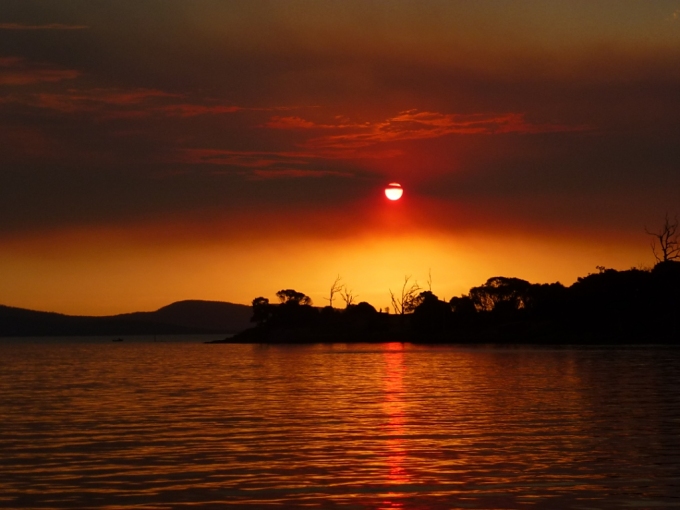
Around 11pm it seemed to be easing and moving further south. Alex went below to get some sleep while Jackie kept watch. Occasional gusts would whip up the flames or a tree falling would cause a shower of sparks and embers over the hill, but the flames came no closer.
At 12:50am, the wind suddenly shifted to the south and within 15 minutes the temperature dropped by 10°C (19°F) and a strong fetch started to roll into the bay. Chaika began to pitch and swing wildly. Alex came up to review the situation. He saw that we were now dragging toward the shore, so he quickly started the motor and began driving slowly upwind to take the strain off the chain. He maintained this from 1am till nearly 5 am.
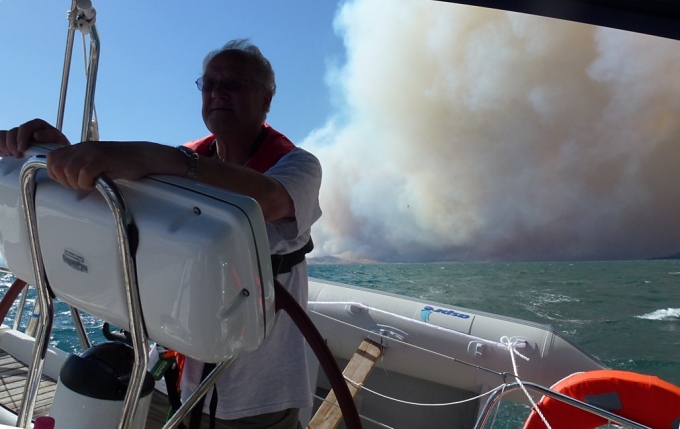
By 5am on Saturday, 5th Jan., the winds had eased further and in the predawn light we decided it was time to head home. We could see fires still smouldering over the hill, but it looked like Sommers Bay itself would be spared. We were very fortunate that our lives were never at risk although we felt sorrow and distress for the folks we’d seen who still didn’t know whether their homes were spared.
All photos and bushfire text by Jackie Zanetti.
For her full story, click here. Thanks for sharing, Jackie.
--------------------------------------------------------------------------------------------------------------------------------------------------------
Days and Ways to Celebrate
A daily list of mostly obscure holidays and fun ways to celebrate them.
Winnie the Pooh Day
It's A. A. Milne's birthday (January 18, 1882). Read a Pooh story or listen to the Nitty Gritty Dirt Band sing “House at Pooh Corner” Hey, don't be an Eeyore!


 Franklin is the oldest township on the Huon River. It's a tiny little port town about 10km from Kermandie. Situated on Shipwright's Point, it boasts an antique shop, a post office, a cafe
Franklin is the oldest township on the Huon River. It's a tiny little port town about 10km from Kermandie. Situated on Shipwright's Point, it boasts an antique shop, a post office, a cafe 










